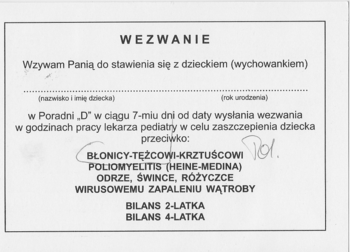A | B | C | D | E | F | G | H | CH | I | J | K | L | M | N | O | P | Q | R | S | T | U | V | W | X | Y | Z | 0 | 1 | 2 | 3 | 4 | 5 | 6 | 7 | 8 | 9


A vaccination schedule is a series of vaccinations, including the timing of all doses, which may be either recommended or compulsory, depending on the country of residence. A vaccine is an antigenic preparation used to produce active immunity to a disease, in order to prevent or reduce the effects of infection by any natural or "wild" pathogen.[2] Vaccines go through multiple phases of trials to ensure safety and effectiveness.
Many vaccines require multiple doses for maximum effectiveness, either to produce sufficient initial immune response or to boost response that fades over time. For example, tetanus vaccine boosters are often recommended every 10 years.[3] Vaccine schedules are developed by governmental agencies or physicians groups to achieve maximum effectiveness using required and recommended vaccines for a locality while minimizing the number of health care system interactions. Over the past two decades, the recommended vaccination schedule has grown rapidly and become more complicated as many new vaccines have been developed.[4]
Some vaccines are recommended only in certain areas (countries, sub national areas, or at-risk populations) where a disease is common. For instance, yellow fever vaccination is on the routine vaccine schedule of French Guiana, is recommended in certain regions of Brazil but in the United States is only given to travelers heading to countries with a history of the disease.[5] In developing countries, vaccine recommendations also take into account the level of health care access, the cost of vaccines and issues with vaccine availability and storage. Sample vaccination schedules discussed by the World Health Organization show a developed country using a schedule which extends over the first five years of a child's life and uses vaccines which cost over $700 including administration costs while a developing country uses a schedule providing vaccines in the first 9 months of life and costing only $25.[6] This difference is due to the lower cost of health care, the lower cost of many vaccines provided to developing nations, and that more expensive vaccines, often for less common diseases, are not utilized.
Worldwide
The World Health Organization monitors vaccination schedules across the world, noting what vaccines are included in each country's program, the coverage rates achieved and various auditing measures.[7] The table below shows the types of vaccines given in example countries. The WHO publishes on its website current vaccination schedules for all WHO member states.[8] Additional vaccines are given to individuals more likely to come into contact with specific diseases through work or travel (e.g. military), or after potentially infectious exposure. Examples include rabies, anthrax, cholera and smallpox.[9][10]

